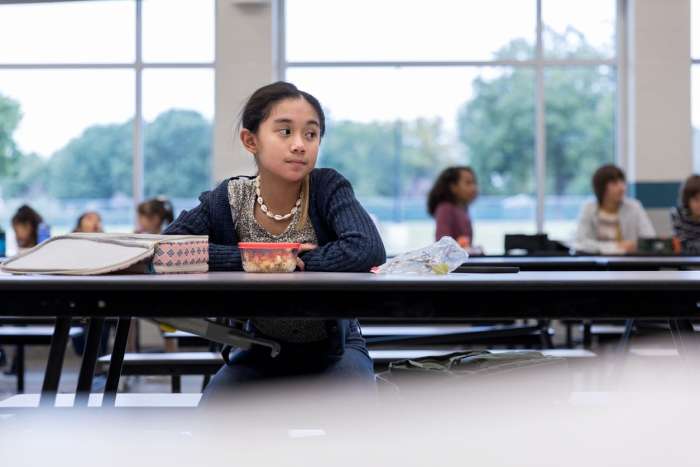Before the term “foodie” was popularized and watching cooking competition shows was a part of a family’s entertainment schedule, American school lunches were typically sandwiches, cheese and crackers, chicken nuggets, burgers, hot dogs, and an odd slice of cold pizza.
Children of immigrants and first-generation Asian Americans who grew up during this time often faced stigmas when they brought in their cultural foods. Whether they were made fun of for the look or the smell of their meals, it created a sense of anxiety whenever they opened their lunchboxes.
The shaming comments at “weird” exotic foods and comments from other kids about traditional Chinese and Japanese lunches being “stinky” is such a universal experience for kids that it’s been deemed a “lunchbox moment.”
Related: How Chinese YouTube Videos Taught My Kids My Native Language
The “lunchbox moment” experience is so universal for Asian-American kids in the cafeteria, that many feel the need to assimilate and start bringing traditional “American” foods, so they don’t stand out. Giving into this bullying for many Asian kids and families can feel like losing part of their cultural identity.
Lunchtime was a reminder that I didn't belong

Growing up as one of the few Chinese kids in a predominantly white community, I always felt like the odd one out; I desperately wanted to fit in. Whenever I left home to go to school, I transformed myself and altered the way I behaved and interacted with others.
15 Social-Emotional Activities for Preschoolers at Home
For decades when parents and educators discussed learning and education, the focus was on academics and how well a child performs in school and tests. The concept of focusing on social skills is still reasonably new, yet it is equally important, and some may argue more. Read More
I spoke English fluently, used idioms and expressions properly, and prided myself on not having an accent. I wouldn't dare utter a Chinese word, fearful that I would further ostracize myself.
I wore the latest trends and listened to the most popular music. I believed that my brown slanted eyes, black hair, and olive complexion didn’t compare to the blue-eyed, blonde-haired, and fair-skinned girls I saw on screen.
It wasn’t just my physical appearance that I felt self-conscious about. Sometimes, lunchtime was a moment that reminded me that I didn’t belong.
"Are you eating frogs and worms?"

The Dragon Boat Festival occurs in late May or June. During this time, my mom would get busy making Zongzi or rice dumplings wrapped in bamboo leaves. She would put delicious pork belly, salted duck egg, Chinese sausage, mung beans, and shiitake mushrooms inside, making them my favorite part of the tradition.
My mom knew that and packed it for my lunch one day. When I opened up my lunchbox, a bunch of kids came over and looked at the oblong-shaped green mound that sat in my container.
The “ewws” surrounded me and a couple of kids even asked if I was eating a frog. I hunched over in shame, gobbling up mouthfuls of sticky rice as quickly as I could.
Another memory that stuck with me was when I brought chow mein to school. Typically, this wasn’t an issue. However, that day, the container was very hard to open.
Using all my might, I cracked open the lid and a bunch of noodles came flying across my desk, landing in the middle of the classroom.
There were bean sprouts, sliced fungus strips, and noodles all over the floor. All the kids gasped in horror, “Katharine’s eating worms for lunch! Ew!”
Trading traditional Chinese meals for ham sandwiches

After those incidents, I begged my mom for sandwiches. And ham was my favorite. I don’t mind a sandwich occasionally but my stomach and heart yearned for the Chinese flavors of my mom’s cooking.
Lunches became a meal that kept me from feeling hungry during the school day instead of a time to savor and appreciate my culture and roots.
Food is a huge part of who I am. It’s not just about the energy it provides my cells so that my body can function properly. There is an entire emotional and social component in every meal, making it the glue that holds families together.
The disconnect I felt from my Chinese culture was exacerbated as I assimilated to the tastes of everyone else.
Teaching my kids to be proud of their Asian heritage and diverse tastes

I didn’t start to accept and embrace my culture until I was at University. By then, I was packing my own lunches and earning money to go out to eat with friends.
From Indian, Mexican, and Korean to Moroccan food, we tried all types of restaurants and cuisines. It was an adventure that excited our taste buds.
So when I became a parent, I vowed to preserve my traditional palate with my kids. I’m the designated cook in our home and I enjoy feeding my family with the flavors of my childhood.
My kids bring leftovers for lunch and I never hesitate to add funny-looking or odd-smelling ingredients to our meals.
Fortunately, global flavors have become more socially accepted as the norm. Hoisin sauce, shrimp paste, and oyster sauce are no longer acquired tastes. Most of the people I meet now know what a moon cake is and when they don’t, they’re curious to try one.
My daughter’s school offers sushi fun lunches once a month. But her favorite is still her mama’s chow mein, something I would have been mortified to bring when I was her age.
Food is a connection to our heritage and history

Every morning when I pack their lunches, I feel a wave of pride and gratitude. It’s a little reminder that the world is changing for the better and that it’s not all doom and gloom with hate crimes, climate crises, wars, and political struggles. We are creating a kinder and more considerate place for our children to inherit.
Thankfully, with the advent of the Internet, globalization, advances in the travel industry and increased awareness of diverse cuisines, kids can now draw comfort in their traditional foods with little hesitation.
Lunchtime has become an opportunity to learn about different cultures, develop an open mind, and expand palates.
If you grew up feeling embarrassed about what your parents put in your school bag, here’s a mother’s heartfelt story of how packing her daughter’s lunch makes her feel more connected to her heritage than she’s ever felt before.



